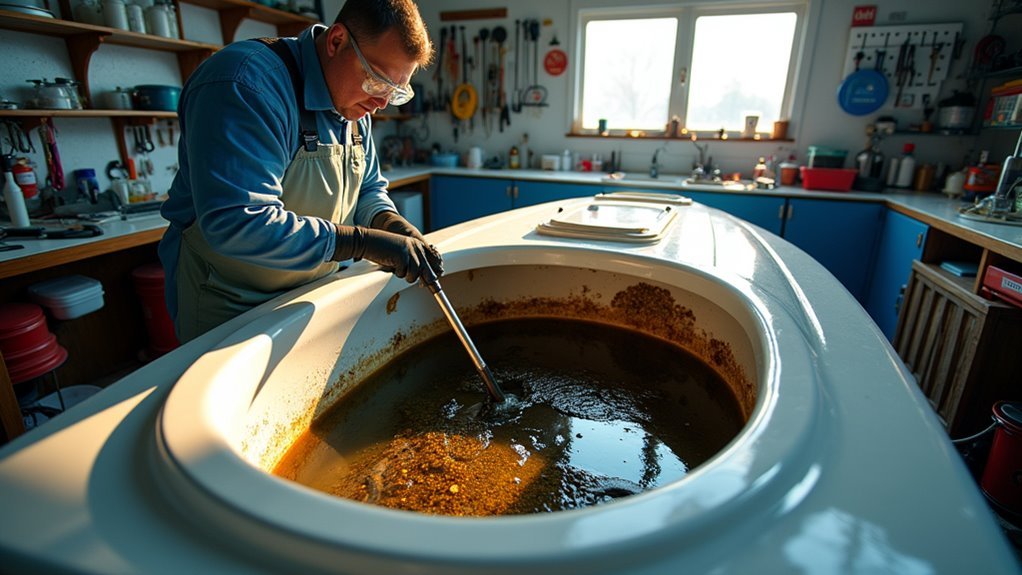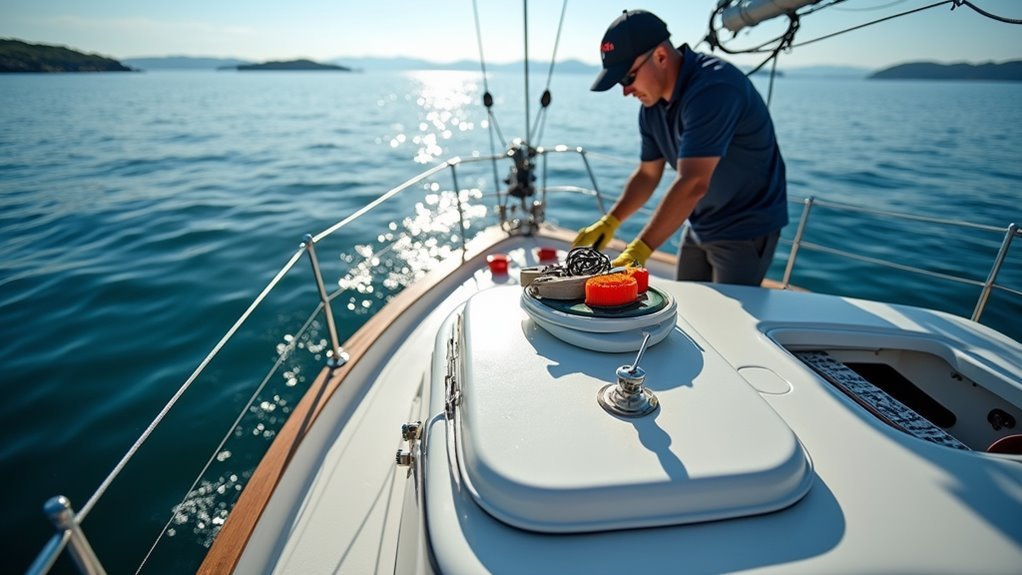Just like a car needs clean gas to run well, your boat’s engine needs clean fuel to work properly. You might notice your boat acting strange – making odd noises, stopping unexpectedly, or losing power when you’re trying to get back to shore. While cleaning a fuel tank isn’t anyone’s idea of fun, knowing how to do it right can save you lots of money on repairs and keep you from getting stuck out on the water.
According to Eric Anderson, a certified marine mechanic writing for Boating Magazine, “The number one cause of engine problems I see in my shop is related to contaminated fuel. A clean fuel tank is essential for your boat’s performance and reliability.”
Fuel Contamination Consequences

When your boat engine suddenly sputters and dies in choppy waters, contaminated fuel is often the culprit.
We’ve seen how quickly things can go wrong—sludge and biological growth disrupt combustion, while filters clog before you’ve burned through 1,000 gallons. Proper maintenance of fuel injectors is crucial to prevent these issues, enhancing fuel efficiency and extending the life of the injection system.
Perhaps most concerning is that these failures tend to happen at the worst times, like in heavy weather when you really can’t afford to lose power.
##
We’ll now walk through the essential methods for cleaning your boat’s fuel tank yourself, along with some potential pitfalls to avoid during the process.
The right approach depends on your tank size, accessibility, and level of contamination, but we’ve found that using products like Sea Foam with the proper technique can make a significant difference. Regular maintenance prevents sludge buildup in your fuel system, ensuring efficient operation and reducing the risk of costly repairs.
Perhaps the most important thing to remember is that patience is key – rushing the cleaning process often leads to incomplete results or, worse, damage to your fuel system.
Things to Do When Cleaning A fuel tank on a boat
Cleaning a boat’s fuel tank is a critical maintenance task that helps prevent engine problems and guarantees peak performance on the water.
Over time, fuel tanks can accumulate water, debris, algae, and fuel residues that compromise fuel quality and potentially damage the engine.
A thorough cleaning removes these contaminants and extends the life of your boat’s fuel system, saving you from costly repairs and unexpected breakdowns during your marine adventures.
- Inspect with digital camera – Examine the tank’s interior, focusing on low spots and baffles to identify contaminants and assess the cleaning needs.
- Apply Sea Foam treatment – Mix with fresh fuel at 50/50 ratio and let soak for 24-48 hours, agitating periodically to dissolve gum and varnish.
- Remove contaminants – Use a suction hose or copper tube wand to extract water, debris, and sediment from the tank’s low points.
- Remove tank if necessary – Disconnect hold-down hardware and extract the tank for more thorough cleaning.
- Pressure wash interior – Use angled tips to reach all areas until wastewater runs clear, typically taking about two hours.
- Install inspection ports – Add access points in each baffled chamber to facilitate future cleaning and maintenance.
- Secure proper sealing – Carefully reinstall all components with new gaskets to prevent leaks and contamination.
- Test system integrity – Run the engine with fresh fuel to verify proper operation before extended use.
Things to Avoid When Cleaning A fuel tank on a boat
Cleaning a boat’s fuel tank is a critical maintenance task that requires careful attention to avoid causing further damage to your vessel’s fuel system.
Improper cleaning methods can lead to persistent contamination issues, engine performance problems, and even safety hazards that could leave you stranded on the water or cause costly repairs.
Understanding the proper techniques and knowing what practices to avoid guarantees that your cleaning efforts will be effective and help maintain your boat’s fuel system integrity.
- Cleaning tanks without inspection ports in every baffled chamber – Without proper access points, you can’t effectively reach all areas of contamination, leaving hidden pockets of debris.
- Relying solely on fuel additives for severe contamination – Products like Sea Foam can help with minor issues but can’t replace mechanical cleaning for significant buildup or biological growth.
- Rushing the cleaning process – Hurried work increases the risk of fuel spillage and incomplete debris removal that can lead to recurring contamination issues.
- Using inadequate tools for baffled areas – Small suction hoses often fail to reach low spots or trapped debris in complex tank designs, leaving behind water and sludge.
- Neglecting to completely drain the tank – Failure to remove water and contaminants from the lowest points promotes algae growth, corrosion, and persistent fuel system problems.
Steps
Properly cleaning a boat’s fuel tank is essential for maintaining engine performance and preventing costly repairs due to contamination.
Fuel tanks can accumulate water, algae, rust, and sediment over time, especially if the boat sits unused for extended periods.
These contaminants can clog fuel lines, damage injectors, and cause engine failure if not addressed.
The following step-by-step process outlines how to effectively clean your boat’s fuel tank to guarantee ideal fuel system performance.
Step 1: Mix Sea Foam Motor Treatment with fresh fuel at a 50/50 ratio.
Step 2: Pour the mixture into the fuel tank, guaranteeing it covers the contamination line.
Step 3: Allow the solution to soak in the tank for 24-48 hours.
Step 4: Periodically agitate the tank by moving it or placing it in direct sunlight to enhance cleaning.
Step 5: After soaking, use a Pela oil extractor or similar suction tool to remove the mixture and contaminants.
Step 6: Focus on extracting from the lowest points of the tank where water and debris settle.
Step 7: Drain the tank completely through the fuel pump or access ports.
Step 8: Use a Racor filter during drainage to catch remaining sediments.
Step 9: For larger tanks, remove the tank by disconnecting hold-down screws and hoses.
Step 10: Pressure wash the interior with an angled tip until clean water emerges.
Step 11: Allow the tank to dry completely before refilling with fresh fuel.
Final Thoughts
Maintaining your boat’s fuel tank doesn’t have to be a challenging task if you follow the steps we’ve outlined above.
Regular inspections and proper maintenance will save you from expensive repairs down the road.
We’ve found that combining methods—like using Sea Foam treatments and thorough extraction—works best.
Perhaps the most important takeaway is consistency; annual treatments with biocides have proven effective in our decade of experience.
##

Maintaining a clean fuel tank is one of the most important yet often overlooked aspects of boat ownership.
A spotless fuel tank isn’t just good practice—it’s essential for every serious boater’s peace of mind.
Regular fuel tank cleaning prevents engine problems, improves fuel efficiency, and extends the life of your marine fuel system.
By following the maintenance steps outlined in this article—annual inspections, using products like Sea Foam for deep cleaning, guaranteeing proper access to all tank chambers, and implementing a regular maintenance schedule—you’ll avoid costly repairs and frustrating breakdowns on the water.
Remember that prevention is always easier than cure. Small efforts like adding fuel stabilizers before storage periods, installing quality fuel filters, and addressing contamination early can save you significant time and money in the long run.
Don’t wait for your engine to sputter or stall before addressing fuel tank cleanliness.
Make fuel tank maintenance part of your regular boating routine, just like checking oil or cleaning the hull. Regular cleaning is essential for maintaining aluminum boat appearance and longevity.
Your boat’s performance, reliability, and your peace of mind on the water depend on it.
Take action today to guarantee your next boating adventure isn’t interrupted by preventable fuel system issues.






